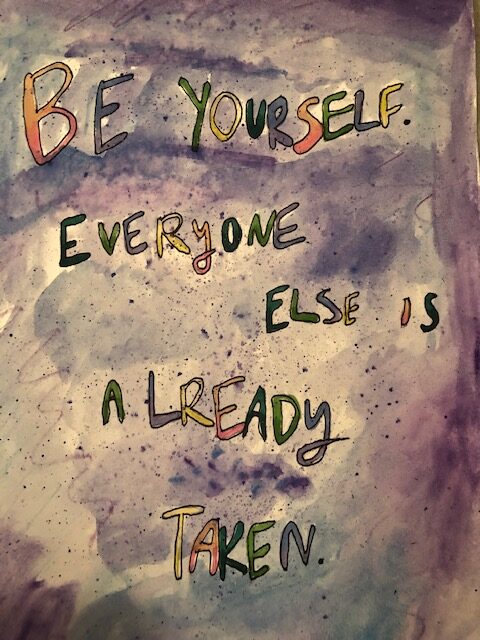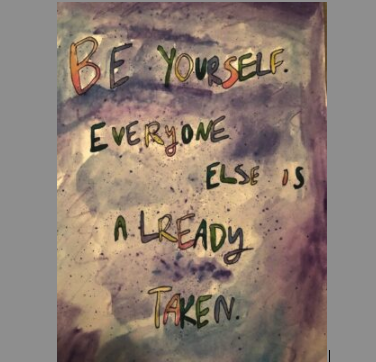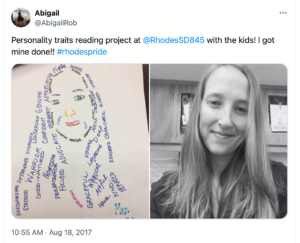“Be yourself; everyone else is taken.”
That. Quote. Drives. Me. Nuts.
I mean, duh! And of course! And who else am I gonna be?!
[Also it makes the librarian in me nuts because it is often attributed to Oscar Wilde, but there is no evidence he ever said it. Additionally, he doesn’t seem to have written it anywhere. But that is a story for another day.]
Honestly, every time I see those words plastered on a wall or shared on social media I think, what does that even mean? What, in fact, does it mean to be me today? Yesterday? Tomorrow? Life, it seems, is about figuring out how to be oneself.
ESPECIALLY in Middle School.
Because early adolescents are experiencing tremendous growth: physically, cognitively, socially, emotionally, and psychologically. And they are asking big questions:
- Who am I?
- Who do I want to be?
- What am I good at?
- Who are my friends?
- How do I fit into this classroom, this school, this world?
That’s why AMLE, in The Successful Middle School: This We Believe, recommends that middle level educators:
“Build opportunities for identity exploration into the curriculum, both within traditional academic classes and through exploratory classes where students might be introduced to new interests and future passions.” (pg. 64)
The Alliance for Excellent Education agrees:
“adolescents need opportunities to explore different aspects of their identities and exercise the social and cognitive tools that allow them to develop agency over their lives. Educators must consider how they shape learning environments and practices to support healthy identity development and provide students with opportunities to direct their own actions and learning.” (pg. 10)
So what does that look like in the classroom?
Let’s start with the basics before we explore some examples in practice.
Identity refers to the characteristics that make us who we are.
There are plenty of ways to define those characteristics, and it often helps to start with some pretty simple prompts. For example:
- What are your likes, interests, hobbies, and talents?
- Who is your family?
- Where is your home?
- What traditions and celebrations are important to you?
- What are your strengths?
- How do you hope to grow?
Teachers can invite students to surface and reflect on these aspects of identity in a variety of ways:
- Write a poem: I Am Poem, I Am From Poem, or Bio Poem
- Draw a map of self: Autobiographical Maps
- Create a zine: All About Me Gazette
- Make a personal trading card
- Develop a take care of me list or a personal user manual
Some characteristics that can help us better understand our identity are defined as social identifiers or identity markers.
These include things like age, race, gender, religion, and more. For many students, these concepts require some unpacking.
OES teachers Kyle Chadburn and Andrea Gratton have an excellent slideshow they use with students. Mount Holly educator Margaret Dunne found that her 4th and 5th grade students loved learning new vocabulary for talking about identity.
As you explore social identity markers with students, you might engage them in reflection on their own identities:
- Identity Wheel from Seed the Way
- Starburst Identity Chart from Facing History
- Student Identity Wheel
- Identity Iceberg
IMPORTANT NOTE (really, super important!!!!):
No one should have to share their identities with others unless they want to. For example, when I use identity wheels with adults I encourage them to share ONLY what they are comfortable sharing. The tools above are for reflection, and students have every right to leave categories blank or to not share their work with others, including the teacher!
Now that we’ve covered the basics, let’s connect this work to the content we already teach!
- Language arts is a natural fit for identity work, check out these ideas from Learning for Justice.
- Use identity markers to analyze characters in class read aloud or book group books. Mount Holly teacher Emma Vastola’s class is reading The Flight of the Puffin and mapping the identities of each of the four characters in the book. Similarly, OES students apply what they know about identity to character studies.
- Create self-portraits:
- Build positive math identities by asking students to share their “mathographies.”
- Use technology to share your learning.
Identity doesn’t just connect to our core disciplines, it is the perfect opportunity to get interdisciplinary!
- This extensive humanities unit from OES’ Andrea Gratton and Kyle Chadburn does just that.
- Combine social studies and art to explore Equity, Identity, and Art.
- Write, record, and share “this we believe” essays.
- Create STEM identity boxes.
- Who Am I?: a science, social studies, and language arts project about identity and heredity.
Go beyond identity to community: moving from me to we!
Knowing and understanding ourselves is the first step to knowing and understanding others. Identity work is a great way to begin the year because it helps know and be known, fostering community and belonging. And it’s also a fabulous first step to building community routines and norms. A few fun protocols (yes, protocols can be fun!) can help students share more about themselves as they consider how to work well together:
Take it one step further: from identity to diversity to anti-bias and justice!
Learning for Justice’s Social Justice Standards outline a trajectory towards more just and equitable schools and communities, and it all starts with identity. Use the grade-level learning outcomes to guide you as you extend identity work into learning about taking collective action for a more just world. And check out these examples from Vermont classrooms:
- The #everydaycourage of talking about race in Vermont schools
- Fostering Brave Spaces
- How Can Students Teach Educators About Social Identity?
Student-centered and personalized learning begins with knowing our students well.
In sum, identity work, to borrow a phrase from the legendary Audrey Homan, is a seed that feeds many birds! Because, of course, students not only learn more about themselves, they also learn more about each other and can share their understandings with their teacher, families, and communities (hello PLP and Student-Led Conference!).
And so we can’t wait to see all of the ways your students express how they are “being themselves.” After all, everyone else is taken!




